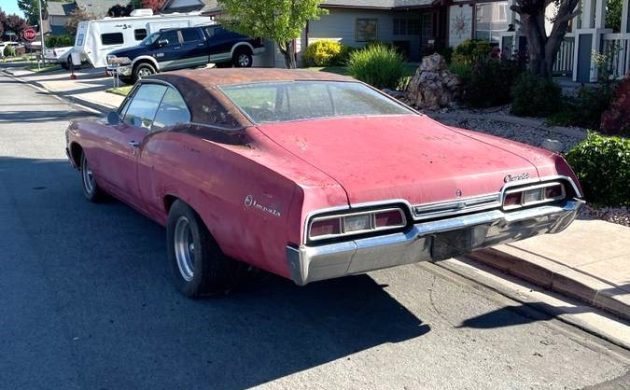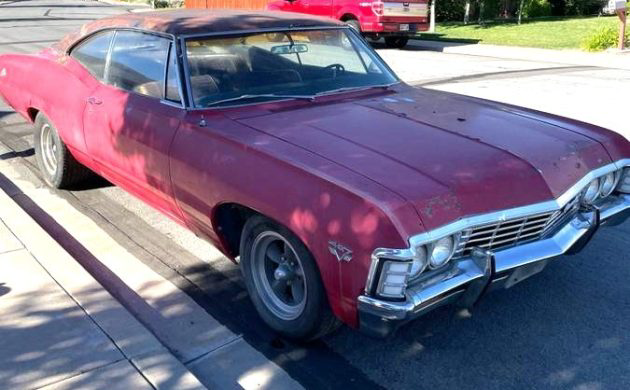Chevrolet’s Impala was still America’s best-selling car in 1967 at more than 575,000 units. It’s likely most were built with a small-block V8 engine, such as the 327. But estimates are that a few were equipped with a 425 hp, 427 cubic-inch big-block that was a power to be reckoned with. If this is a real-deal factory 427, this ’67 Impala could be a rare car. But there’s no indication the engine and 4-speed manual transmission couldn’t have been dropped in later, too. Our thanks to Rocco B., for this interesting tip!
One source indicates that just 11 of the L72 427s went into big Chevies in 1967. After all, the Impala was a family car, so why would you want to go that route? Because muscle was in favor and everybody in the business was offering one kind of performance car or another. This Impala has no Super Sport badging anywhere which might lessen the likelihood of a completely original find.
The seller doesn’t go into the history of this car, so a build sheet or some other proof would help. There are 427 emblems on the front fenders, but they could have been added. Though the red paint is quite faded and the car’s former vinyl roof covering is gone, we’re told there’s no rust on this machine. Perhaps because it’s been in the Southwest for a long time. It starts but will need carburetor work and a tune-up after sitting for an extended period.
A restoration is in order, including the interior which may clean up well enough but if you’re going to do the rest, why not the passenger compartment, too? Also, the gauges need to work, but we don’t know what that means. From Sparks, Nevada, this interesting old Impala is available here on craigslist for $14,000 OBO. Bring a trailer as it’s not ready for extended drives.






They didn’t have to be an SS, to order a 427, was a couple in my town back in the day.
This is a really interesting Chev. If I were looking for a project I’d have to take a look. It has what looks like a solid body, and I’ve always liked 4 speed cars with a bench seat.
Looking at the 427 badging, that wasn’t a yesteryear add on. This car may be a Unicorn.
Even a Unicorn in this condition isn’t worth $14k. $10 on its best day.
That’s an incorrect badge on the fender !
You need to have evidence, not speculation.
No L72s built. That’s a fact. The one in Hemmings years ago was a fake.
The 427 badges on this car was for an SS 427, not just any old 427 Impala, which had different badges. Car is lacking SS 427 equipment otherwise, so it would take more sleuthing to see what this car really is.
But it’s not an L72.
A $34,500 savings over the 1967 Chevy BelAir from yesterday. I would probably take my chances on this one.
If this thing is a true L-72 4 speed, it is one seriously rare car. The chances of finding one are crazy. Because of the rarity of a real one, I am highly skeptical of this car. To be quite frank, if it is original, $14,000 is a steal. I live within 800 miles of Sparks, and I may very well take a little trip to check this out. Given the rarity of a real one, I can’t believe that the seller didn’t include a photo of the VIN or the block stamping.
Charles please go check it out! Let us know if it’s real! Can you imagine if they’d have dropped that configuration in a Nova at the factory! I’m not a real Chevy fan but they had it going on in the 60’s!
One day I will own another one
Bad-ass! Even if it’s not original, I would love to have it. 427 emblems don’t look original, but the transplant is what we did. Underpowered? Replace that anemic 327 with a Corvette 427. Instant Hotrod!
The ad doesn’t mention 427, only big block, the picture of the emblem 427 is where the idea this is car has a 427 cake from. As for 427’s being from a Corvette, there were probably more 427’s sold over the counter as crate engines than installed into cars at the factory. I worked at a speed shop, the owner said they would buy performnce GM and Ford crate engines 50 at a time. Customers would buy them for boats, hot rods and race cars. They had some pictures with pallet racking full of various engines, still in the crates stacked 2 deep from the floor to the ceiling. One of those pictures was used on the back page for one of their catalogs.
Steve R
The article not only mentions a 427 motor, but also an L-72. While most commonly associated with the Corvette, the L-72 was an order option on full size Chevrolet’s in ’66, ’67, and ’68. The chance that this is a factory L-72 is almost zero, but what if is?
I’m not sure what your point is. History lessons are fine, but that has nothing to do with the ad. If the seller thought this car came from the factory with a 427 or there was one currently installed they would say so. That would bring them more money and make the car easier to sell. If I lived in the area and was in the market I’d contact the owner. Regardless of what’s currently in the car or was when it left the factory, the car very well could be well worth the asking price. It should stand or fall on its own merits.
Steve R
Charles, no L72 in 1967, but was available in 1969.
The VIN and casting numbers would sort the origins of this out in about 5 minutes. Even if it’s a transplant, if it’s a 1960’s L72 and a Muncie gearbox, you’re getting your money’s worth.
The sellers ad makes no mention of L72. It’s great to dream though.
The Craigslist ad states no rust, I guess that’s air vents on the driver side top side window trim
There is no rust, so it might just be some dry rot that you see in the low resolution photos, but not rust.
Does anybody else see what I see, rubber will dry rot, wood and upholstery will dry rot, I didn’t know that metal can dry rot, so I guess the whole top isn’t surface rust, it’s just surface dry rot.
Why can’t folks leave the valve covers, and the original air cleaner alone, as God, and GM intended? I’m a stickler for originality.
The existence of 1967 with factory-installed L72 engines is very much disputed. There was one making the rounds of the magazines a few years ago, but it was eventually determined not to be a factory installation. If I recall correctly, the figure of 11 comes from the number of L72 engines delivered to one of Chevrolet’s factories during the model year, but that doesn’t necessarily mean that they were installed into production cars. There was a 385-HP version that was available in every full-sized 1967 Chevy. You could even order a 427/4-speed wagon.
No L72 i full size cars, just L36 –385 HP 67 was not a good year for L72, in 66 and 68 and 69 L72 was available in full size cars, not in 67. Thirty years ago we had this discussion in all the Chevy clubs I had a 67 Caprice and it was a 427 L36 and it was really quick
Every 427 I’ve seen in a impala was always 385 hp!
The fender flag emblems are for only the special 67 “SS427” option (to be differentiated from a “regular” SS with a 427 engine). But the car is not an SS (neither “regular” nor “SS427”); so the flags are obviously not original to the car.
In addition to all the aftermarket stuff under the hood, the radiator is a reproduction 62-63 409 unit. The car looks likely to be just a cobbled together assemblage of various parts from many sources.
And there is nothing in the ad to suggest that it is, or is claimed to be, an L72 (transplanted or otherwise), or even that it was born as a 4-speed car. This car is no more likely a factory L72 (if they had ever built any in 67 in the first place) than any of the thousands of other 67 Impalas on the internet right now with big blocks sitting under the hood.
Sometimes it is easier to just look at the sale ad and pics, and not let speculation in an article about what it “might” be lead you down a dead end road!
Jeffschevelle is right. A non SS 427 full size Chevy would have used the above 427 flags. The 427 (but not the L72) could have been ordered in any full size Chevy in 1967. While in highschool, a guy a year older than me somehow scored a non SS 67 Impala convertible. He was not a car guy but was really good at partying. Before long the convertible was well beat and eventually just left behind an abandoned gas station. One of my gearhead heroes rescued what was left and the 427 ended up in a 56 210 2 Dr sedan. Now, 50 years later, I recently heard that that fellow passed away and the 56 plus years of other cool stuff was sold by his estate. The above flags came off the 67 convert shell.
What’s with the Hep-Cat search terms at the bottom of the ad: “Impala caprice chevy classic Chevrolet Pontiac gm gmc buick regal Oldsmobile cutlass 442 lowrider Monte carlo donk glasshouse bomb”.
gmc?
buick regal?
donk glasshouse bomb?
WHAT?
Find the numbers on tab on the block. It’s easy to see on one these. Ya may need to have some degreaser and or a flat edge or thin chisel to top remove the crap built up.on it, but it’s going to be there. If the digits match it’s gold. If not you’re going to need to have a build sheet to prove it was ever a factory L72 built car. If was real the seller should have just taken shot that block number.
The firewall painted the body colour says the car’s been doctored a bit. GM cars had a black firewall, with only the cowling painted the body colour. That’s my understanding. Still, for 14G this looks like a decent body/engine combo to work with. Can’t get behind a 4-speed with a bench seat, though.
Having had a 67 Caprice Sport Sedan with the 325hp 396, that 427 fender emblem just doesn’t look right. That said there were multiple emblems used
I remember reading an account in a magazine years ago that said the commodious (thank you Steve Magnante) trunk of the ’67 Impala was large enough to hold the hood of a ’57 Chevrolet and still close the trunk.
Anybody know if it’s true? It certainly looks like it may be possible from the outside.
I wonder if Chevy made any L-72 4 speed CAPRICES in ’66-69, especIally a ’68 with insanely rare optional hidden headlights – at the very least if you knew someone or were an exec.